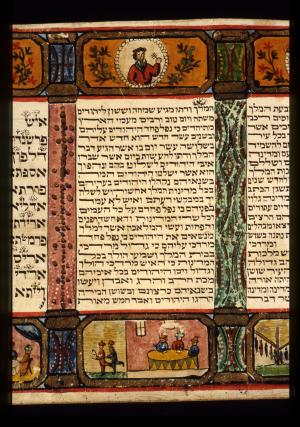Obj. ID: 23622
Hebrew Illuminated Manuscripts Hand-Painted Copy of Esther Scroll with Portrait Medallions, Austria, late 19th century

A hand-made colorful and simplified copy of a popular type of printed megillot decorated with medallions containing the busts of the Esther story protagonists that were produced in Amsterdam at the beginning of the 18th century (in the Index see Esther scrolls "Portrait Medallions"). The original decoration is replaced by two twigs placed parallelly to the right edge of the first sheet. The upper margins are divided into sections equal to the text panels placed below them and each of them contains a roundel with a bust flanked by two twigs except for the first and last panels; in the first, the royal couple is depicted and the last is blank. The text panels are interspersed by narrow vertical panels decorated with different ornaments. The lower margins are filled with figurative scenes that chronicle the narrative of the Book of Esther and Midrashic tales. An additional illustration is included in column no. 19. Not all the episodes are depicted in the scroll in chronological order. All frames of the panels with busts and narrative scenes are painted gold. In the last panel, the benediction after the Megillah reading and the shortened version of ארור המן Arur Haman are inscribed. The scroll ends with decoration similar to the one at its beginning.
To the right edge of the first membrane, a pull bar of wood is stitched. The scroll is mounted on steam with ivory handle and finial that is 390 mm high.
In the institutional and private collections, other scrolls decorated with a similar pattern are stored.
sub-set tree:
*Manuscripts and Printed Books | Esther scroll (megillat Esther) | with benedictions
*Manuscripts and Printed Books | Esther scroll (megillat Esther) | with piyutim
*Manuscripts and Printed Books | Esther scroll (megillat Esther) | in ha-melekh layout
The scroll consists of 3 membranes containing 22 text columns with 22 lines, except for col. 19 with 11 lines divided into two parts.
Every letter ל in the words המלך occurring in the first lines of the text columns is decorated with elaborate tagim.
The text includes an enlarged ח (Es. 1:6) that is formed of two parts joined with a roof and its legs end with serifs. In the text, the enlarged letter ת (Es. 9:29) is included too. In addition, traditional enlarged and diminished letters are in col. 19; they are also decorated with elaborated tagim and in the case of two of the letters, additional strokes are drawn below them.
In the first text panel are inscribed all three benedictions preceded by an adequate Hebrew headline ברכות מגלה. Whereas the last panel contains the final benediction followed by a shortened version of ארור המן Arur Haman.
In general, the ruling is slightly visible.
The parchment is bright; both sides of the sheets are very similar so it is difficult to distinguish between the flesh and hair side of a sheet.
The membranes are glued which was relatively rare for Esther scrolls.



















